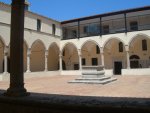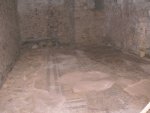Parco Archeologico Urbano dell’antica Volcei (created in 1996) is a fascinating place where many finds were discovered, they g
 ive the possibility to reconstruct the life of ancient Buccino, of Middle Ages and later periods. The ancient and the modern towns coexist.
ive the possibility to reconstruct the life of ancient Buccino, of Middle Ages and later periods. The ancient and the modern towns coexist.Naturalistic tourism is developing fast, thanks to the presence of the park Dardano-Melara, made of beeches, where many different kinds of mushrooms can be found and of the fluvial park Sele-Tanagro-Calore.
Hand-made pasta festival, in August, is very nice.
The ancient Volcei (volcan) was founded by Pelasgi-Oenotri and was dominated by different populations since Neolithic period. Volcei developed after VII century b.C. and it was mentioned in some works by Plinius. It belonged to the 12 towns of Lucania and then it was defeated by Rome, thus becoming a Roman town (Municipium Volcentium). Hannibal stayed in Buccino when preparing his attack against Rome.
In 1300 Buccino was donated by Angevins to Count Giorgio Lamagna, who rebuilt and fortified the castle around which the modern town developed.
Then the county passed to Ferrante Caracciolo, duke of Martina and count of Buccino.
Buccino took part to Risorgimento.
Monuments and natural beautes of Buccino
 Eremitani
Eremitani
di Sant’Agostino Monastery, built in XIII century, inside there is a charming Angevin-style cloister, built in 1476, designed by the architect
Natale di Ragusa surrounded by 23 columns with Corinthian capitals coming from a Roman temple.
At the entrance there is a hall surrounded by a portico. Today it is the seat of the town hall
 Castello: Castello Imperiale. Papa Urbano VI took refuge in it, when he was persecuted by Carlo Durazzo.
It was built during Middle Ages, between XI and XII century. It is in Parco Archeologico Urbano dell’antica Volcei
Castello: Castello Imperiale. Papa Urbano VI took refuge in it, when he was persecuted by Carlo Durazzo.
It was built during Middle Ages, between XI and XII century. It is in Parco Archeologico Urbano dell’antica Volcei
 Parco Archeologico Urbano dell’antica Volcei (created in 1996) is a fascinating place where many finds were discovered, they give the possibility to reconstruct the life of ancient Buccino, of Middle Ages and later periods. The ancient and the modern towns coexist. Roman shops of I century b.C. are very interesting, then there is the forum, Santo Stefano necropolis dedicated to the cult of the water (in III century b.C.), a rich tomb of a girl belonging to one of the richest family of the town as the jewels in her tomb testify
Parco Archeologico Urbano dell’antica Volcei (created in 1996) is a fascinating place where many finds were discovered, they give the possibility to reconstruct the life of ancient Buccino, of Middle Ages and later periods. The ancient and the modern towns coexist. Roman shops of I century b.C. are very interesting, then there is the forum, Santo Stefano necropolis dedicated to the cult of the water (in III century b.C.), a rich tomb of a girl belonging to one of the richest family of the town as the jewels in her tomb testify
Rupestrian complex of via Egito: ancient rock settlement of the VI-VII century. A.D. similar to the most famous stones of Matera. These are caves dug into the rock and used as dwellings where Byzantine or more generally oriental hermits found shelter.
Santa Maria Solditta Church, on the façade there are still XVI century elements
Santa Maria delle Grazie monastery, it belonged to Franciscan order. Inside there is a Baroque statue of the Immaculate Conception. In the side naves there are small altars and niches
Santa Maria Assunta Church, the façade is covered by bricks. There are some XIX century wood statues and a pipe organ made in the second half of 1700
San Nicola Church of XIV century with a stone bell tower
Palazzo Cocozziello, built in 1700 on an ancient Roman temple and Palazzo Forcella, built in 1700
San Giovanni Gerosolimitano Church, with a nice painting portraying the baptism of Jesus Christ by Gaetano D’Agostino
Chiesa dell’Annunziata, with a beautiful bell tower
Tempe del Mulino, where Tanagro and Bianco rivers meet
Parco Dardano-Melara, made of beeches, where many different kinds of mushrooms can be found and fluvial park Sele-Tanagro-Calore. In these rivers trouts and eels live. On the sides of them there are poplars, alders and willows

